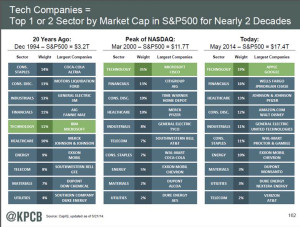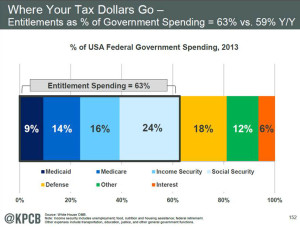When Mary Meeker talks, the digerati listen. Meeker is the digital industry analyst who’s a partner at KPCB, a venture capital company, in Silicon Valley. Each year she publishes a report on the state of the digital marketplace. Her 2014 paper, Internet Trends 2014 – Code Conference (dated May 28 2014) is online, and as usual, it’s full of data points on both digital technology segments along with some vertical industry findings – in education, financial services, and health, among other segments.
I’ve combed through the 164 pages of the PDF to trend-weave the health implications. When it comes to health, the top-line for Meeker is stated concisely on page 29: “Healthcare = May Be @ Inflection Point.” She explains her rationale for this assertion on the following 3 pages:
- Healthcare economics: costs have reached 17% of the U.S. GDP, and 27% of health spending is wasted. Over 25% of family income is likely to go to health spending in 2015, and 50% of bankruptcies are driven by health costs. Chronic conditions eat up most health care spending, and behavior is the root of many health problems – lack of activity, eating wrong, lack of medication adherence, among these mis-behaviors.
- Reasons for optimism: the HITECH Act is investing $35 bn in electronic health records for providers, the ACA is expanding health-covered lives, and most consumers want access to tools and websites that will enable their taking on true consumer workflow for health.
- The “green shoots” data: health care is getting more digital (e.g. growing EHR adoption, consumers want to email doctors), payment is moving from volume-based to value-based, and employers are marrying wellness programs to health plans to bolster behavior change. Patient engagement is yielding hard-dollar savings, citing examples from Redbrick Health, Teladoc, Mango Health, and WellDoc.
Beyond these 4 pages in the report which explicitly speak to “health,” other content lays a foundation for understanding digital opportunities for the health industry. Re-imagining Apps, for example, is an important concept in health to help people streamline their personal healthcare workflow – moving toward multi-purpose mobile apps and the “rise of the invisible app.” The “Biggest Re-Imagination of All,” Meeker claims, is people enabled with mobile devices coupled with sensors, resulting in troves of findable and shareable data. This could also be huge in health care – facilitating peer-to-peer health care, faster clinical trials research, just-in-time health nudges to help people change behaviors they want to change. But this also creates new challenges related to individual rights — a huge topic these days in the era of #BigData in health care. Some caveats are key in health care – notably Meeker’s important inclusion of “RIP Bad User Interfaces,” featuring a graveyard of “Bad UI” drawn by John Maeda, a design partner of KPCB. Where’s the good UI? Maeda includes Apple, airbnb, Nike, nest, and Instagram as role models. There’s much more trendweaving you can do by combing through this seminal report with your own lens (or pair of Google Glasses). You can read my take on Meeker’s previous internet trend reports: The role of internet technologies in reducing health care costs: Meeker inspirations, May 30, 2013 Meeker & Murphy on Mobile, through the lens of health, February 11, 2011  Health Populi’s Hot Points: Meeker identifies the top technology companies by industry on page 162 of the report, from 20 years ago to 2014. Note that in health care, the top two companies in terms of market cap in December 1994 were Merck and Johnson & Johnson; in May 2014, the top two were Johnson & Johnson and Pfizer. What’s particularly noteworthy is looking at the top companies in other industry sectors in May 2014: in telecomms, Verizon and AT&T; in consumer staples, Walmart and Procter & Gamble; and in general tech, Apple and Google. In each of these cases, the companies all have quite specific strategic plays in health and health care. What more open data and APIs, ubiquitous wireless and broadband networks, and mobile platforms provide together are infrastructure for moving information around where it needs to go, so imperative in health care especially as consumers take on more self-health, healthcareDIY responses in the value-based healthcare payment environment.
Health Populi’s Hot Points: Meeker identifies the top technology companies by industry on page 162 of the report, from 20 years ago to 2014. Note that in health care, the top two companies in terms of market cap in December 1994 were Merck and Johnson & Johnson; in May 2014, the top two were Johnson & Johnson and Pfizer. What’s particularly noteworthy is looking at the top companies in other industry sectors in May 2014: in telecomms, Verizon and AT&T; in consumer staples, Walmart and Procter & Gamble; and in general tech, Apple and Google. In each of these cases, the companies all have quite specific strategic plays in health and health care. What more open data and APIs, ubiquitous wireless and broadband networks, and mobile platforms provide together are infrastructure for moving information around where it needs to go, so imperative in health care especially as consumers take on more self-health, healthcareDIY responses in the value-based healthcare payment environment.  So it’s prescient of Meeker (no surprise) to fold into the paper the graph on page 152 titled “Where Your Tax Dollars Go” — entitlement spending as a percent of government spending in 2013. Entitlement spending, she calculates comprised 63% of U.S. Federal spending in 2013. Medicaid and Medicare added up to 23%, income security 16%, and Social Security, 24%. Entitlements as a percent of total Federal spending grew by 4 percentage points in a year. Consumers — health citizens, patients, people — will be taking on more financial skin in the health care game in 2014 and ongoing. Governor Mike Pence of Indiana has introduced a new consumer-driven Medicaid plan that puts enrollees into the position of consumers managing health accounts. Employers are advancing high-deductible health plans coupled with health savings accounts for working insured people, bundling in wellness programs to bolster behavior change (motivating folks with both carrots in the form of premium discounts, for example, as well as sticks on the other side — for people who do not meet specific health goals, like quitting smoking or lowering BMIs). Health care is indeed at an inflection point, and the many trends Meeker discussed are the basis for optimism that we have — on the technology and tools side of the equation — growing infrastructure, platforms, apps, and data analytics capabilities to support more self-health and more cost-effective care. The limits on the optimism have more to do with consumer engagement and motivation, education, and privacy concerns than with the technology.
So it’s prescient of Meeker (no surprise) to fold into the paper the graph on page 152 titled “Where Your Tax Dollars Go” — entitlement spending as a percent of government spending in 2013. Entitlement spending, she calculates comprised 63% of U.S. Federal spending in 2013. Medicaid and Medicare added up to 23%, income security 16%, and Social Security, 24%. Entitlements as a percent of total Federal spending grew by 4 percentage points in a year. Consumers — health citizens, patients, people — will be taking on more financial skin in the health care game in 2014 and ongoing. Governor Mike Pence of Indiana has introduced a new consumer-driven Medicaid plan that puts enrollees into the position of consumers managing health accounts. Employers are advancing high-deductible health plans coupled with health savings accounts for working insured people, bundling in wellness programs to bolster behavior change (motivating folks with both carrots in the form of premium discounts, for example, as well as sticks on the other side — for people who do not meet specific health goals, like quitting smoking or lowering BMIs). Health care is indeed at an inflection point, and the many trends Meeker discussed are the basis for optimism that we have — on the technology and tools side of the equation — growing infrastructure, platforms, apps, and data analytics capabilities to support more self-health and more cost-effective care. The limits on the optimism have more to do with consumer engagement and motivation, education, and privacy concerns than with the technology.




 I am so grateful to Tom Lawry for asking me to pen the foreword for his book, Health Care Nation,
I am so grateful to Tom Lawry for asking me to pen the foreword for his book, Health Care Nation,  I love sharing perspectives on what's shaping the future of health care, and appreciate the opportunity to be collaborating once again with Duke Corporate Education and a global client on 6th May. We'll be addressing some key pillars to consider in scenario planning such as growing consumerism in health care, technology (from AI to telehealth), climate change, and trust -- the key enabler for health engagement or dis-engagement and mis-information. I'm grateful to be affiliated with the corporate education provider
I love sharing perspectives on what's shaping the future of health care, and appreciate the opportunity to be collaborating once again with Duke Corporate Education and a global client on 6th May. We'll be addressing some key pillars to consider in scenario planning such as growing consumerism in health care, technology (from AI to telehealth), climate change, and trust -- the key enabler for health engagement or dis-engagement and mis-information. I'm grateful to be affiliated with the corporate education provider  Thank you FeedSpot for
Thank you FeedSpot for